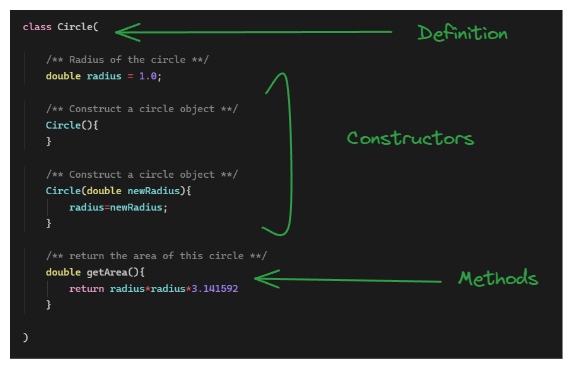Convention
OOP is a paradigm or Methodology to design a program using classes and objects. It makes it easy to maintain and modify and cuts down the development time. We can simply inherit characteristics from existing ones. Control of variable flow. OOP also Dumps & Destroy unused object or classes freeing up system memory.
POP v/s OOP
| Procedural Oriented Programming | Object Oriented Programming |
|---|---|
| In procedural programming, program is divided into small parts called functions. | In object-oriented programming, program is divided into small parts called objects. |
| Procedural programming follows top-down approach. | Object-oriented programming follows bottom-up approach. |
| There is no access specifier in procedural programming. | Object-oriented programming provides access specifiers like private, public, protected, etc. |
| Procedural programming does not have any proper way for hiding data, so it is less secure. | Object-oriented programming provides data hiding, so it is more secure. |
| In procedural programming, function is more important than data. | In object-oriented programming, data is more important than function. |
| Examples: C, FORTRAN, Pascal, BASIC, etc. | Examples: C++, Java, Python, C#, etc. |
Java & OOP Concepts
OOP Features available in Java:
OOP Classes
Classes in Object-Oriented Programming (OOP) act as templates or blueprints that define the behavior and state that objects of a particular type will support. They serve as constructs that outline the structure of objects sharing the same characteristics.
A class consists of variables, which define the data fields, and methods, which define the behaviors. Additionally, classes provide special types of methods called constructors, which are invoked to create and initialize objects from the class.
A blur definition
To design a class, if we can identify a noun from a given problem statement and associate relevant attributes with it, we can implement it as a class in the program.

Example
class Student {
int id;
String name;
public static void main(String args[]) {
Student s1 = new Student();
System.out.println(s1.id);
System.out.println(s1.name);
}
}Explanation:
- Class Definition:
- A class named
Studentis defined with two instance variables:int id(default value is0for integers in Java).String name(default value isnullfor objects in Java).
- A class named
- Object Creation:
- Inside the
mainmethod, an objects1of classStudentis created usingnew Student();. - Since no values are assigned, the default values of instance variables will be used.
- Inside the
- Printing Values: ^6c352c
System.out.println(s1.id);→ Prints0becauseintvariables in Java are initialized to0by default.System.out.println(s1.name);→ PrintsnullbecauseStringvariables are object references and are initialized tonullby default.
Output:
0
null
Key Takeaways:
- Default Values in Java:
- Primitive data types (e.g.,
int,float) have default values (e.g.,0,0.0). - Reference types (e.g.,
String,Object) default tonull. - These objects have a default constructor to it that they are initialized to 0/Null.
- Primitive data types (e.g.,
- Object Instantiation:
- When an object is created using the
newkeyword, memory is allocated, and default values are assigned to instance variables.
- When an object is created using the
Example 2
class Student {
int id;
String name;
}
class TestStudent1 {
public static void main(String args[]) {
Student s1 = new Student();
System.out.println(s1.id);
System.out.println(s1.name);
}
}Explanation:
- Class Definition (Student):
- A class
Studentis defined with two instance variables:int id;→ Default value:0(primitive type).String name;→ Default value:null(reference type).
- A class
- Separate Main Class (TestStudent1):
- In the
TestStudent1class, themainmethod is defined. - An object
s1of typeStudentis created usingnew Student();.
- In the
- Printing Values:
System.out.println(s1.id);→ Prints0as default forint.System.out.println(s1.name);→ Printsnullas default forString.
Expected Output:
0
null
Key Points:
- Class and Object Concept:
- A class acts as a blueprint, and objects are instances of the class.
- When an object is created, its instance variables are assigned default values.
- Default Values in Java:
- Primitive types (like
int) are initialized to0. - Reference types (like
String) are initialized tonull.
- Primitive types (like
- File Naming Conventions
- A file can have multiple classes stored in it.
- But ONLY ONE of those class should have void main.
- And the ONE with the void main should be the name of the file.
Example 4
class Student {
int rollno;
String name;
void displayInformation() {
System.out.println(rollno + " " + name);
}
}
public static void main(String args[]) {
Student s1 = new Student();
s1.rollno = 54;
s1.name = "Ram";
s1.displayInformation();
}```
54 Ram
### **Explanation:**
1. **Class Definition (Student):**
- The class `Student` contains two instance variables:
- `int rollno;` → Stores the student's roll number.
- `String name;` → Stores the student's name.
- A method `displayInformation()` is defined to print the values of `rollno` and `name`.
2. **Object Creation and Data Assignment:**
- In the `main` method, an object `s1` of type `Student` is created using `new Student();`.
- The attributes of the object are assigned values:
- `s1.rollno = 54;`
- `s1.name = "Ram";`
- The method `s1.displayInformation();` is called to print the values.
3. **Printing Values:**
- The method prints the assigned values of `rollno` and `name` separated by a space.
### **Expected Output:**
### **Key Points:**
- **Object Initialization**
- After creating an object, values can be assigned to instance variables directly.
- **Method Invocation:**
- Methods in the class can be used to manipulate and display object data.
- **Encapsulation Best Practice:**
- While this example directly accesses instance variables, it's generally recommended to use getter and setter methods to ensure [[data encapsulation]] in real-world applications.
---
# References
###### Information
- date: 2025.01.20
- time: 08:08